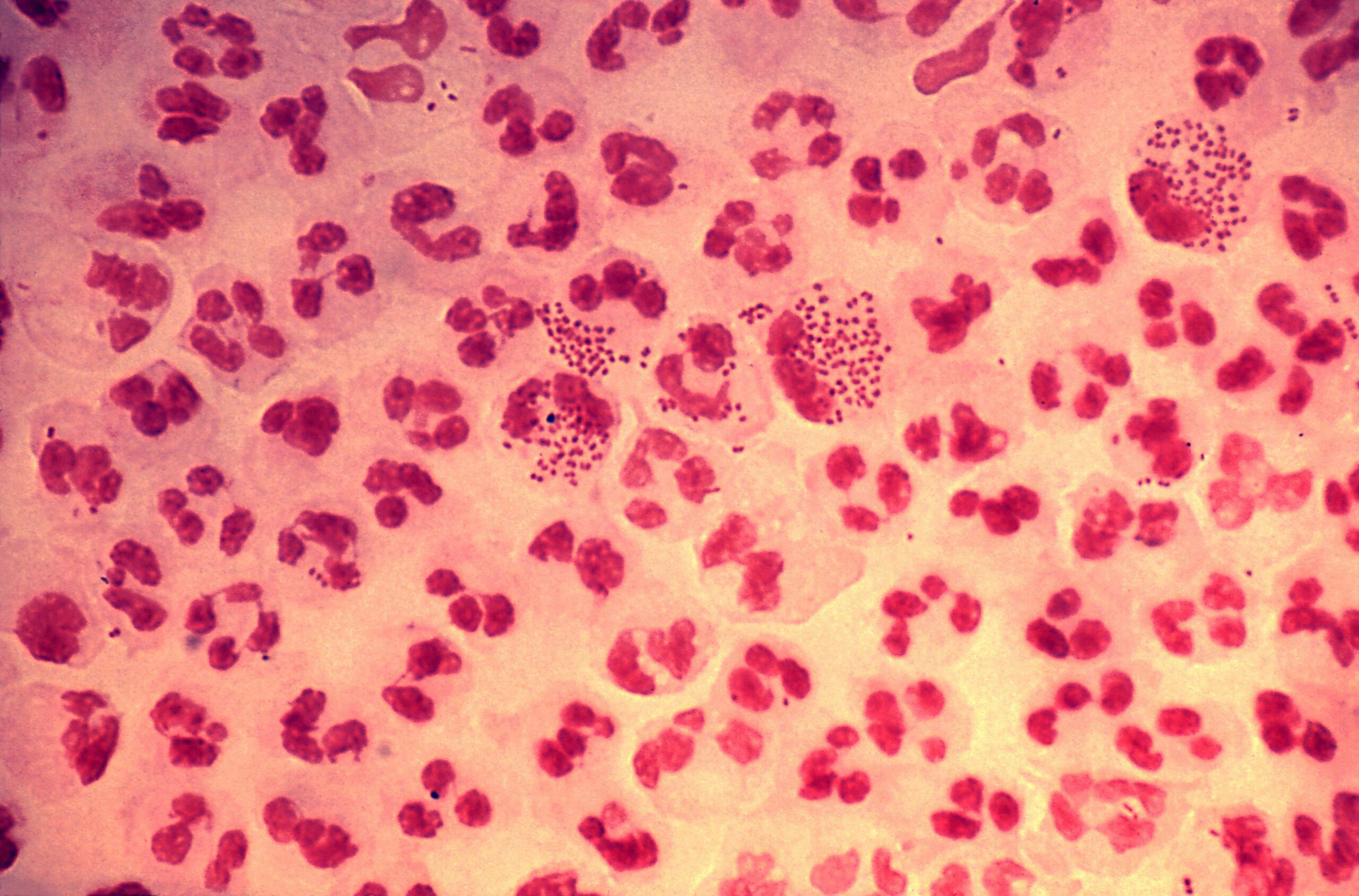Playlist
Show Playlist
Hide Playlist
Gonorrhea: Signs, Symptoms & Diagnosis
-
Slides Urethritis InfectiousDiseases.pdf
-
Download Lecture Overview
00:01 Now as far as the clinical features of gonorrhea go, this organism is notorious for producing very, very severe dysuria. 00:14 Urination is extremely painful. 00:18 It would be very unusual if gonorrhea were totally asymptomatic. 00:23 It's possible but very unusual. 00:28 The urethral discharge may start out as scant and mucoid. 00:33 But within 1 to 2 days, it is frank pus. 00:37 Interestingly enough, in contrast to urinary tract infections, there's not the urgency to urinate, and urinary frequency is not common, like it is in a urinary tract infection. 00:55 If patients don't seek treatment, this syndrome will resolve in several weeks. 01:05 And this cartoon shows what these organisms look like under the microscope. 01:12 You notice that they are inside of neutrophils. 01:16 And they are diplococci, pairs of cocci. 01:21 And the other thing to notice is that the flat sides of these cocci are apposed. 01:27 They are not end to end like in Streptococcus pneumoniae. 01:32 So biscuit-shaped diplococci, notably inside of neutrophils. 01:42 Now to prove that a patient has gonorrhea versus non-gonococcal urethritis, you would want to culture the discharge and Gram-stain the discharge. 01:57 The typical culture media is a media known as Thayer-Martin medium. 02:06 Thayer-Martin is nothing more than chocolate agar, which will grow many, many organisms, and supplies hemin and nicotinamide adenine dinucleotide to fastidious organisms. 02:19 So many things will grow on Thayer-Martin media, but we're only interested in isolating Neisseria gonorrhoeae. 02:30 So how do we get rid of the other organisms that might grow? Well, what we would do is we put antibiotics into the medium. 02:39 For example, we put vancomycin and you may know that vancomycin is broad spectrum for Gram-positive organisms. 02:49 So therefore, no Gram-positives should grow on Thayer-Martin. 02:54 The other thing in Thayer-Martin is colistin. 02:58 Colistin is a broad spectrum, Gram-negative antibiotic. 03:03 In other words, for Gram-negative rods like E. coli, like pseudomonas, and other things that may tend to grow. 03:13 But those won't grow with colistin added to thayer-martin media. 03:18 And finally, nystatin which is an antifungal agent will keep the growth of yeast and other fungi away. 03:29 And so therefore, Thayer-Martin media is a highly selective media. 03:36 In general, you use Thayer-Martin only for Neisseria gonorrhoeae. 03:42 There are other things you would use chocolate agar for but for Thayer-Martin, it's gonorrhea. 03:50 Now as far as the Gram-stained smears, we've already discussed that they're Gram-negative intracellular diplococci. 04:00 In contrast, this particular view with the cartoon shown. 04:05 But I think you can still see the these are flat sides apposed Gram-negative diplococci. 04:13 And the Gram stain is very, very sensitive in symptomatic men. 04:21 In other words, Gram-stain that discharge and you should be able to find these organisms. 04:28 However, if the unusual scenario obtains that the man is asymptomatic, then the Gram stain is only 50% sensitive. 04:43 What is now being used in many laboratories, instead of culture is something called the nucleic acid amplification test. 04:56 This has largely replaced cultures for screening, especially in asymptomatic genital infections. 05:05 And the test is able to detect not only Neisseria gonorrhoeae, but it's often combined to detect Chlamydia trachomatis. 05:19 However, it is not more sensitive than a regular culture. 05:26 It just depends upon the facilities that the laboratory has. 05:31 However, it is very, very sensitive for Chlamydia trachomatis and culturing Chlamydia trachomatis is cumbersome and not used widely. 05:45 But the bottomline is that all patients with urethritis should be tested for both Neisseria gonorrhoeae and Chlamydia trachomatis.
About the Lecture
The lecture Gonorrhea: Signs, Symptoms & Diagnosis by John Fisher, MD is from the course Genital and Sexually Transmitted Infections. It contains the following chapters:
- Gonorrhea – Signs/Symptoms
- Gonorrhea – Diagnosis
Included Quiz Questions
What would you expect to see on a urethral smear from a patient with gonorrheal urethritis?
- Intracellular gram negative diplococci
- Extracellular gram negative diplococci
- Intracellular gram positive diplococci
- Extracellular gram positive diplococci
- Extracellular gram negative bacilli
What is the best medium for culturing Neisseria gonorrhoeae?
- Chocolate agar with vancomycin, nystatin, and colistin
- Cycloserine, cefoxitin, fructose, and egg yolk (CCFA) agar
- MacConkey agar
- Lactose agar
- Mannitol salt agar
Which of the following statements regarding the use of nucleic acid amplification testing (NAAT) in the evaluation of urethritis is MOST ACCURATE?
- It can identify both gonococcal urethritis and Chlamydia infection.
- It is highly sensitive for Chlamydia infection, but a poor test for gonococcal urethritis.
- It is rarely performed due to high cost.
- It is highly sensitive for gonococcal urethritis, but a poor test for Chlamydia infection.
- It is a poor test for either gonococcal urethritis or Chlamydia infection.
Customer reviews
5,0 of 5 stars
| 5 Stars |
|
5 |
| 4 Stars |
|
0 |
| 3 Stars |
|
0 |
| 2 Stars |
|
0 |
| 1 Star |
|
0 |





